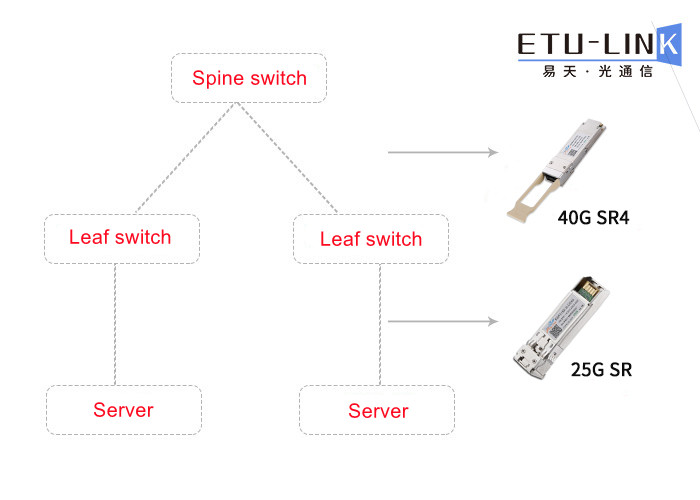
Advantages and solutions of 25G/100G Spine-Leaf network structure
From the perspective of the development trend of data centers, the trend of "cloud" and digitalization of enterprises is irreversible. The ICT industry such as cloud computing, big data and artificial intelligence has an increasingly large demand for data centers. The bandwidth demand of data centers is growing at a rapid rate of 25% to 35% every year, and the bandwidth capacity is also doubling. The following we will talk about the advantages and solutions of Spine-Leaf network structure.
Data center as a new infrastructure, it is necessary to consider the deployment of 25G/100G or more high bandwidth network. With the maturity of standards and improvement of technology, 25G/100G high rate optical modules are commercially available, which provides feasibility for the deployment of leaf ridge networks in data centers. Compared with the traditional three-tier hardware architecture, leaf ridge architecture is more in line with the development trend of data centers. Its advantages are as follows:
1. Load balancing. The uplink of each leaf switch works in load balancing mode, making full use of bandwidth.
2. Estimated delay value, the number of connected paths between leaf switches can be determined, all of which only need to pass through a ridge switch, and the east-west network delay can be predicted.
3. Good scalability. Most switches that support 25 Gbit/s /100 Gbit/s are backward compatible with 10 Gbit/s /40 Gbit/s, providing higher flexibility for switch ports and network expansion.
4. Reduce switch performance requirements. Southbound traffic can be exported from leaf nodes or ridge nodes. The east-west traffic is distributed on multiple paths. This eliminates the need for expensive high-performance high-bandwidth switches.
5. High security and availability. In the blade ridge architecture, when a device fails, it does not need to converge again and traffic continues to pass through other normal paths. The network connectivity is not affected and the bandwidth of only one path is reduced.
In the design of the blade ridge architecture, more than 90% of the optical fiber link length of the small and medium-sized data center is less than 100 m. The link deployment scheme mainly adopts multi-mode optical fiber, and the optical module deployment is mainly 40/100G.
To form a 25G/100G Spine-Leaf network, 25G servers, 25G switches, 100G switches, 25G SR optical modules, 100G SR4 optical modules, OM3 fiber patch cords, and distribution frames are required.

To connect a 25G server to a 25G switch (downstream port), use a 25G SR optical module with OM3 multimode fiber patch cord. To connect a 25G switch (upstream port) to a 100G switch, use a 100G SR4 optical module with OM3 multimode fiber patch cord.
The new blade ridge network adopts the flat large layer 2 architecture, enlarges the access and convergence layer, and greatly improves the network efficiency. Moreover, it does not need to purchase high-performance core switches. Instead, it is networked by relatively small medium and low-end switches, and mainly adopts 40G/100G bandwidth deployment (large data centers can consider the prospective deployment of 200/400G bandwidth). Support full speed east-west traffic, while reducing enterprise deployment and maintenance costs, to provide a practical and effective development strategy for data centers.
Categories
New Blog
Tags
© Copyright: 2025 ETU-Link Technology CO ., LTD All Rights Reserved.

IPv6 network supported
Friendly Links:
易天官网